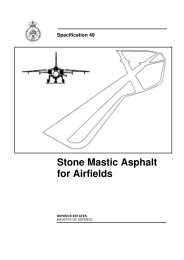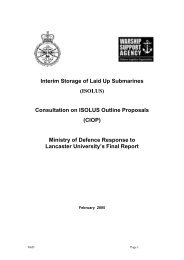Part III - Historical Survey of the Porton Down Service Volunteer ...
Part III - Historical Survey of the Porton Down Service Volunteer ...
Part III - Historical Survey of the Porton Down Service Volunteer ...
You also want an ePaper? Increase the reach of your titles
YUMPU automatically turns print PDFs into web optimized ePapers that Google loves.
9.4.6. GF human studies<br />
The Adrian conditions explicitly limited human studies with nerve agents to GB, yet GF was<br />
used in human studies which started in <strong>the</strong> summer <strong>of</strong> 1963. It is not clear how <strong>the</strong>se studies<br />
came to be carried out. In June 1963 <strong>Porton</strong> hosted a meeting <strong>of</strong> a working party set up by<br />
<strong>the</strong> 16 th Annual Tripartite (UK, US and Canada) Conference to consider nerve agents o<strong>the</strong>r<br />
than GB [71]. The working party concluded that GF (among o<strong>the</strong>rs) was worth studying in<br />
more detail but no agreement is recorded that <strong>the</strong> UK should carry out <strong>the</strong> work. The GF<br />
studies were a breach <strong>of</strong> <strong>the</strong> Adrian conditions. Yet, <strong>Porton</strong> reported <strong>the</strong>m widely in annual<br />
reports [72, 73], from which it might be inferred that permission to conduct <strong>the</strong> work had been<br />
obtained. The survey has found no reference which confirms this inference.<br />
Before <strong>the</strong> studies began an estimate was made, from ma<strong>the</strong>matical formula, <strong>of</strong> <strong>the</strong> GF LD50<br />
in man: a figure <strong>of</strong> 24 µg/kg emerged. The dose expected to induce a mean ChE depression<br />
<strong>of</strong> 50% was estimated to be 2.8 µg/kg. Fifty six men inhaled doses <strong>of</strong> GF by single breath.<br />
Initially, <strong>the</strong> doses used were 0.16 µg/kg, gradually being increased as <strong>the</strong> safety <strong>of</strong> each<br />
dose was established to a maximum <strong>of</strong> 2.84 µg/kg.<br />
The maximum ChE depression observed was 70%, in one man who received <strong>the</strong> maximum<br />
dose. In October 1963 <strong>the</strong> initial results were reviewed at <strong>Porton</strong> and a maximum dose <strong>of</strong><br />
2 µg/kg was imposed for <strong>the</strong> remaining work [74]. Thirty men participated in this work which<br />
used doses <strong>of</strong> 1.24 µg/kg, 1.56 µg/kg or 1.89 µg/kg [70].<br />
The results <strong>of</strong> this work were noted to be "unduly variable" [74] and fur<strong>the</strong>r human studies<br />
were stopped in early 1964. The Director <strong>of</strong> <strong>Porton</strong> stopped any fur<strong>the</strong>r work with GF but did<br />
not cite <strong>the</strong> Adrian conditions in doing so. Instead he noted that "<strong>the</strong> present interest in GF<br />
does not justify any fur<strong>the</strong>r testing on humans" [75]. No references to later GF human studies<br />
have been found.<br />
9.5. Human studies to investigate miosis<br />
9.5.1. Predictability <strong>of</strong> miosis<br />
Work before 1954 had established that GB induced miosis. Initially, work after 1954 sought<br />
to identify if <strong>the</strong> degree and onset <strong>of</strong> miosis could be predicted. The first human study<br />
involved 240 men being exposed to GB at 5 mg.min/m 3 , 10 mg.min/m 3 or 15 mg.min/m 3 (t = 1<br />
minute or 2 minutes) [76]. Pupil size was measured before exposure and every 30 seconds<br />
during and after exposure. All men wore respirators, so only <strong>the</strong> eyes were exposed. Some<br />
men had <strong>the</strong>ir eyes bandaged; o<strong>the</strong>rs received atropine before <strong>the</strong> exposure. Pupils became<br />
constricted much more slowly with <strong>the</strong> lowest <strong>of</strong> <strong>the</strong> three doses, although no great difference<br />
was observed between <strong>the</strong> two higher doses.<br />
The second study was carried out in September and October 1957 [77] involving drops <strong>of</strong><br />
dilute GB being instilled directly onto <strong>the</strong> eye. A 0.01 ml drop <strong>of</strong> 0.01% solution <strong>of</strong> GB,<br />
equivalent to 1 µg <strong>of</strong> GB, may have been used [78], this being <strong>the</strong> approved drop used in later<br />
studies. Forty-eight men took part in this study [79], which again aimed to understand if <strong>the</strong><br />
response <strong>of</strong> <strong>the</strong> eye to GB could be predicted. No report <strong>of</strong> this study has been found. The<br />
only o<strong>the</strong>r reference found to this study is that 2 volunteers who participated were admitted to<br />
<strong>the</strong> medical treatment room complaining <strong>of</strong> sleeplessness and gastric trouble [80].<br />
The third study sought to determine <strong>the</strong> doses <strong>of</strong> GB required to reduce <strong>the</strong> pupil to 50% and<br />
10% <strong>of</strong> its pre-exposed size [81]. This study was carried out in 1968 [82, 83]. The study<br />
used goggles to expose <strong>the</strong> eye to GB vapour. The goggle method, developed in 1967,<br />
allowed a measured amount <strong>of</strong> GB vapour, usually 1 µg, to be passed over <strong>the</strong> eye [84]. The<br />
goggle method appears to have been calibrated from July to November 1967 [84, 85, 86] with<br />
<strong>the</strong> help <strong>of</strong> volunteers. In <strong>the</strong> 1968 study which followed, 26 volunteers participated. Some<br />
had <strong>the</strong> same eye exposed 2 or 3 times: in total 62 exposures were conducted. The results<br />
<strong>of</strong> <strong>the</strong> study were [81]:<br />
84









